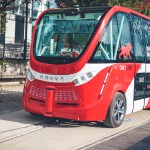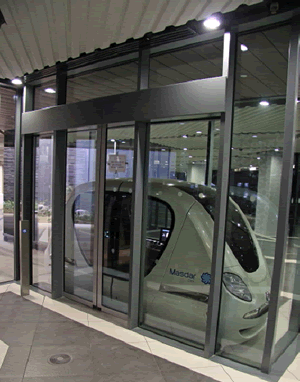Hey, Driver?
It’s not just cars. Driverless mass transit may be coming to a city near you.
Driverless Mass Transit
Driverless cars are no longer a future-tech fantasy. So get ready for what inevitably comes next: driverless everything else. Cities around the world will soon see driverless trains, buses, planes, shuttles, ferries, taxis, and other forms of mass transit.

Navya’s ARMA driverless bus has been delivered to 45 cities around the world. Image courtesy of Navya.
The same technology that enables small, unmanned vehicles to pilot around a city can also be implemented in public transportation systems. Multiple cameras observe road or rail conditions, radars help measure distances, LiDAR helps evaluate routes, and microphones transmit sounds to computers that translate that information into driving decisions.
Over the years, we’ve covered driverless car technology extensively in Connector Supplier, observing its development and its recent arrival on city streets. The same systems and connectors that enable these vehicles to operate, sense their surroundings, and make safe movements throughout a complex urban environment are now being utilized in larger vehicles and public transit scenarios. They raise certain questions — about safety, personnel issues, and performance — that are being handled differently around the world, as each city weighs its comfort level with the new vehicles. But they are coming nonetheless, perhaps even to your own city.
Driverless Buses
Autonomous buses that utilize the same technology found in self-driving cars are rolling out around the world. These small buses, most of which are manufactured by the French company Navya, can reach speeds of up to 28mph, hold a battery charge that lasts up to 13 hours, and evaluate road conditions to make safe operating decisions using the same complex network of cameras, sensing technology, and communication systems. Eventually, these buses could connect with traffic lights and other transport infrastructure to create more efficient routes, and could also connect with the public through their devices and applications.

Mcity provides driverless vehicles with a real-world-like testing ground. Video courtesy of the University of Michigan.
This fall, students at the University of Michigan in Ann Arbor, MI, will be able to hop on a driverless shuttle bus that can carry up to 15 students on the two-mile route from the Lurie Engineering Center to the North Campus Research Complex. Initially, it will be limited to this fixed route. The electric vehicle is manufactured by Navya and is being launched in partnership with Mcity, the university’s 32-acre testing facility, which features built-to-scale, simulated streetscapes that provide a realistic driving environment. This facility is the testing ground for the self-driving cars produced by many leading automakers. Mcity works with automakers, government, and tech startups.
Navya has also opened a manufacturing facility in Ann Arbor to produce the driverless ARMA shuttle for the US market. Since 2015, NAVYA has deployed in 45 cities across the globe.
In Tallinn, Estonia, two driverless buses hit the streets in a one-month trial run in August. Local driving laws require that a responsible person be onboard, so the bus has a host who explains the technology to passengers new to the world of autonomous vehicles. That trial run exposed some flaws in the vehicle’s system when it failed to yield to a police vehicle with flashing lights and ignored a red light at a pedestrian crossing. Some fine-tuning is clearly needed.
A similar trial conducted in Taiwan is considered successful enough that “the goal is to have all the driverless bus-related technologies and infrastructure tested to see how it fits onto our streets within one year,” said Taipei Department of Information Technology Director Lee Wei-bin.
Taiwan is especially well-positioned to embrace driverless public transit, because many of the components used in the vehicles can be manufactured there, including their IT panels, routers, motors, and battery management systems.
Additionally, a driverless bus is coming to Sydney as part of Australia’s Olympic Park. A trial version has already been running between popular tourist destinations in Perth, and more trial buses are scheduled to run at Adelaide Airport and Flinders University.
Driverless Trains
Driverless trains are also becoming a reality in cities around the world. These sleek, fast vehicles serve fixed routes on fixed tracks, eliminating many of the variables that other autonomous vehicles must navigate, and enabling them to run at high speeds. One of the world’s fastest driverless trains is in development for Qatar. The Doha Metro will have 75 automated trains there that will run at speeds of up to 62mph (100km/h).

2getthere is bringing driverless trains to cities around the world. Image courtesy of 2getthere.
Dutch tech firm 2getthere is making a fleet of 25 driverless trains, called automated people movers, to connect Dubai’s inner-city metro system to one of the city’s planned waterfront developments, Bluewaters. Each people mover can carry up to 24 passengers and makes the 1.5-mile (2.5km) trip in 4.5 minutes. Rather than run on rail track, these people movers will operate on an elevated, bi-directional line. However, the vehicles will also have the capability to navigate public roads.
In India, Delhi Metro is planning to run a driverless train between Kalindi Kunj and the Botanical Garden in Noida. Trials have been running for more than seven months. “Currently, we are focusing on coordination between the communication based train control (CBTC) system and the platform screen doors, which is being done for the first time in India,” said Anuj Dayal, executive director (corporate communications), Delhi Metro.
“CBTC is a signaling system that makes use of the telecommunication between the train and track equipment for traffic management and infrastructure control. Through CBTC, the position of a train is known more accurately than with the traditional signaling systems. This results in a more efficient and safe way to manage the Metro traffic,” he explained. “We have to be absolutely meticulous and thorough in these trials. Hence, we cannot fix a particular date for completion of trials.”
Driverless Planes
In a recent survey, 54% of respondents said they wouldn’t book a flight on a driverless plane. Even so, Boeing is set to begin trials for its own automated planes, starting with luggage-carrier aircrafts. “The basic building blocks of the technology are clearly available,” said Mike Sinnett, former chief systems engineer on the 787 Dreamliner and now vice president at Boeing, where he’s responsible for innovative future technologies, at a briefing before the Paris Air Show. Relying on artificial intelligence to guide a passenger plane over cities does raise concerns, he notes, but the technology is already in place in most modern aircraft.
“Automation in the cockpit is not a new thing — it already supports operations. However, every single day pilots have to intervene when the automatics don’t do what they’re supposed to,” said Steve Landells, a flight specialist with the British Airline Pilots Association. “Computers can fail, and often do, and someone is still going to be needed to work that computer.”
In other words, “driverless,” even advanced as it has become, has its limitations. So, at least for the foreseeable future, at least one human will always be working behind the scenes of driverless tech to get you to your destination on time and in one piece.
Recently posted:
[related_posts limit=”10″]
- Meet the Connector: DIN Standard Connectors - April 16, 2024
- Software-Driven Radio Reinvigorates Old Technology - April 9, 2024
- What is a Busbar? - April 2, 2024






